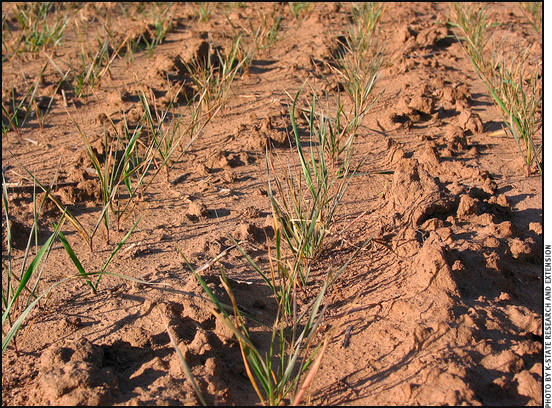
A field of wheat with poor tillering and low vigor, growing on a field with a soil pH of 4.6.
Root of the Problem
Poor wheat tillering, root development may be due to aluminum toxicity.
If wheat growth and vigor is poor this fall, one possible cause is aluminum toxicity associated with low-pH soils, says Dorivar Ruiz Diaz, Kansas State University (K-State) Research and Extension nutrient management specialist.
Aluminum toxicity begins to occur where soil pH levels are less than 5.0 and potassium chloride-extractable free aluminum levels are greater than 25 parts per million (ppm), Ruiz Diaz says. Some varieties of wheat, such as Everest and Overley, have better tolerance to low-pH soils and high aluminum levels than other varieties, such as Fuller.
The symptoms of aluminum toxicity include poor tillering and sometimes, but not always, a purplish color, he says.
"In addition, older leaves may appear drought-stressed and withered. Plants will either be stunted throughout the season even with adequate moisture and nitrogen, or may even die," he said.
High concentrations of aluminum will reduce development of the roots, giving them a short, stubby appearance.
"The roots will often have a brownish color, and the root tips may have a burned appearance. This effect on roots will limit nutrient uptake, and plants may show some deficiency symptoms even with good nutrient levels," Ruiz Diaz says.
In addition, low soil pH (below 5.0) can reduce the availability of plant nutrients such as calcium (Ca), magnesium (Mg), phosphorus (P) and potassium (K).
There's not much a producer can do to correct aluminum toxicity problems once the wheat has emerged, he says.
"However, the producer should make a note of this condition and take action before planting another crop on that field. Lime application on low-pH soil should be considered a high priority. Even half-rates of lime will do some good," he says. "In addition to liming, it helps to use P starter fertilizer when planting wheat on low-pH soils, which would help to reduce free aluminum in the soil solution."
For fields showing mild cases of this problem this fall, wheat may grow out of the condition later in the season, Ruiz Diaz adds.
"This is assuming that soil pH deeper in the profile is higher and growing roots can reach these areas with better pH levels as plants develop later in the season. However, even for a crop that may grow out of this, the effect on yield potential can be significant," he says.











